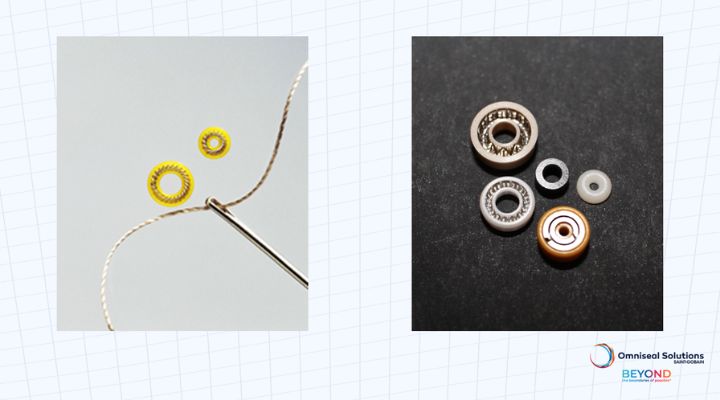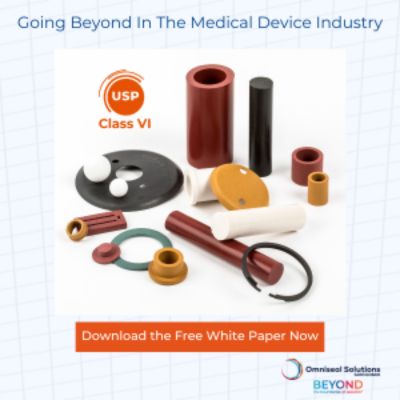Seals are typically a small component in comparison to many other pieces of a medical device, but the job they perform is substantial. These parts must withstand varying temperatures, chemicals, pressures, and other forces while protecting delicate parts or ensuring a connection is solid and without leaks. Seal failure can be critical for a patient and cannot occur within a medical device.
As such, there are a number of factors medical device designers need to consider when developing a product that will require a seal. Fortunately, there are manufacturing partners to whom an engineer can look for support so they know specifically what aspects they need to be concerned with for their specific product and design.
Taking time to review the multitude of features that need to be selected for the right seal is Ronelle Decker, market development manager of Life Science for Omniseal Solutions™ - Saint-Gobain. In the following Q&A, she provides insights on material selection, device design considerations, and the impact outside forces can have on the seal.
Sean Fenske: Can you first start by explaining what a seal is exactly and what it’s purpose is within a medical device?
Ronelle Decker: Seals are used in many life science applications, including diagnostic and analytical equipment, as well as medical, surgical, and home healthcare devices. The seal is a component that prevents the escape or entry of fluids, gases, or other contaminants. Seals also provide wear and friction control for lifetime use and requirements. They can also offer superior wear and friction control in oscillating or reciprocating applications, as well as running requirements, high load, speed, and temperature environments. Seals can be found in various places within medical devices, such as between two parts of a device or at the interface between a device and a patient's body. Seals help to maintain the integrity and function of the device. Without high precision seal materials, medical devices could fail to function properly or may pose a risk to patient safety.
All Omniseal Solutions™ sealing materials are designed to provide the precise level of sealing required by medical device applications. A wide variety of materials are available for low friction and wear results, resistance to soft or hard metal surfaces, broad chemical compatibility, temperature ranges, and pressures. In the life science industry, proper sealing can protect integral components and result in substantial cost saving for the end user by extending maintenance cycles and increasing the overall life of the application.
Fenske: What are the primary considerations when seeking a seal solution? What factors are most important?
Decker: There are four important factors to consider. First, the seal material must be compatible with the fluids and gases the device will meet. This is important to ensure the seal will not degrade or fail prematurely. Next, the seal must be able to withstand the operating conditions of the device, such as temperature, pressure, and mechanical stress. Third, the seal design must be appropriate for the specific application and must be able to maintain the required level of sealing performance over time. Finally, the manufacturing process used to produce the seal must be capable of consistently producing seals of the required quality and performance.
Fenske: As medical devices become smaller, how does this impact the seal design and what you’re able to do as the seal provider?
Decker: Smaller medical devices require seals that are more precise and have tighter tolerances. With smaller devices, there is less space for the seal, thus requiring custom seal designs. Our expertise in materials offers unique options that can withstand higher pressures and temperatures in a smaller package.
The space available for assembly is also reduced. Omniseal Solutions™ offers advanced manufacturing processes and technologies to produce seals that meet these stringent requirements for increasing precision. Our engineers design seals that can be easily installed into tight spaces and require minimal tools and equipment.

Sealing solutions can be quite small while still being durable for their environment.
The desire for smaller, more portable medical technologies (e.g., minimally invasive devices and implants) is on the rise. Due to this, materials with improved properties including strength, flexibility, and biocompatibility are now required. Omniseal Solutions™ has many manufacturing methods and materials to cost-efficiently manufacture small component parts. This includes micro and injection molding, as well as modified machined manufacturing methods.
As an example, Omniseal® sealing solutions for micro-motors and shafts can be as small as 1.0 mm, which are some of the smallest available. Designs for the motors have included material to minimize shaft friction, maintain seal width, and protect shaft bearings.
If you wish to discover more, see our case study on a microsurgical device miniature motor.
Fenske: What are the most common materials used for medical device sealing solutions? What drives the selection of one material over another?
Decker: Omniseal Solutions™ offers a wide range of materials to design the most efficient and adequate sealing solutions. In addition, we often take our recommendations further by offering material solutions for components within the same area as the seal, such as bearings or supporting hardware.
Our material brand Fluoroloy® includes many different PTFE compounds, but also UHMWPE base compounds, specifically formulated to provide maximum sealing efficiency.
For other components where we usually need materials with superior mechanical properties, we rely on our Rulon® product line (PTFE compounds), Meldin® (polyimide materials), and Meldin® HT (thermoplastic materials).
Our unique proprietary materials are designed to accommodate a wide range of applications. The polymer materials, which come in hundreds of formulas, are used to create precise bearings, piston rings, cup seals, and wear components. They are commonly used for medical device seals due to their high chemical resistance, low friction, and ability to withstand high temperatures and high pressure.
Fenske: In terms of a device design, is the seal too often an afterthought? Do companies come to you once they realize they need a seal? How do you address this issue?
Decker: More and more, our customers are involving us at a very early stage of the equipment development as they know that beyond the supply of the seal, we also have a large material solution portfolio, which brings additional value by adding features to the sealing solutions. In many circumstances, depending upon the application, design changes are needed to incorporate and include the seal, so using our design engineering expertise early in the process provides the best outcomes.
In addition, we have many applications where we are asked to upgrade an existing solution that is not providing the intended value and performance. The business model of Omniseal Solutions™ has always been based on a co-development approach and the development of custom solutions leverages our global engineering and manufacturing presence.
Fenske: What aspect of seals are often overlooked or neglected to be considered by medical device designers? What should they keep in mind?
Decker: The chemical compatibility and high purity must be considered by medical device designers. One of the most crucial criteria in the life science sector is biocompatibility, which ensures materials not only endure chemistry and the application environment, but also do not have an adverse effect on the device performance or the human body.
Omniseal Solutions™ has a complete offering of Rulon® and Fluoroloy® materials that are certified USP Class VI. See our USP Class VI white paper for an overview of this certification and learn more about our certified USP Class VI material solutions.
In addition, as I mentioned previously, keeping in mind the dimensions needed to incorporate the seal or the ability to install the seal is key to the design. The inner and outer dimensions of the seal must allow for enough material for effective sealing. Too thin a wall or inability to incorporate a necessary energizer to perform as required will cause a problem.
We also offer testing and simulation services to improve performance, reduce customer testing, and minimize reiterations of the seal and component parts. This offers customers a better understanding of how the seal will perform ahead of testing and reiterations.
Fenske: Do you have any additional comments you’d like to share based on any of the topics we discussed or something you’d like to tell medical device manufacturers?
Decker: When considering a seal, there are important factors to keep in mind to ensure an accurate design, including material, energizer (e.g., spring, O-ring), type of seal (e.g., spring-energized, lip), type of spring (multiple design options), and/or back-up ring (e.g., stainless steel, polymer). Operating conditions must also be added to the mix, such as static, rotary, and/or reciprocating; media (fluid or gas); pressure(s); speed (rpm); and temperature(s). Finally, keep in mind the hardware, including materials; hardness; coating(s); and dimensions such as shaft diameter, housing diameter, and tolerances.
Click here to learn more about Omniseal Solutions™ >>>>>













